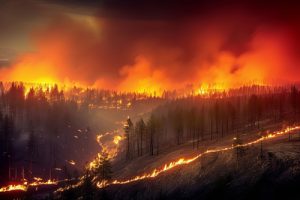Province pledges funds towards drought resiliency, infrastructure
Dave Lueneberg,
Local Journalism Initiative Reporter
“We have to find better ways to maximize our province’s water supply, not just for today but also for future Albertans.”
Those were just some of the words used by the province’s environment minister, Rebecca Schulz, March 13 as the Alberta government announced $35 million in funding toward what it believes could be another devastating year for drought and, if so, would be the third straight for southern Alberta.
“The largest water-sharing negotiations in provincial history are underway. We’ve also set up a drought command team and launched a new water advisory committee,” Schulz said during a provincewide press conference.
“We’re doing advanced modelling with industry, municipalities and Indigenous groups, and many others, to make every drop this year count.”
Schulz and her government feel one of the ways to do that is to improve wetlands, calling them a natural protection against drought, and has earmarked $8.7 million of the overall total for the Wetland Replacement Program and a further $3.5 million for its Watershed Resiliency and Restoration Program.
“As in the past, community organizations, our local non-profits who do amazing work on ground, municipalities and Indigenous communities … they can apply for this funding, and then we roll that out so they can do the good local work that they do,” the minister responded, when asked how the funding will be handed out.
Since 2020, the government says, it has distributed over $14 million to the Wetland Replacement Program and a little over $11 million for watershed resiliency and restoration.
It’s all part of a bigger picture, though.
On March 4, the province unveiled $125 million in funding, over five years, for its newly set up Drought and Flood Protection Program; the $35 million announced is a portion of that.
“It would (if the budget is passed) help communities across the province build the practical infrastructure they need to help protect people’s homes and keep businesses going, regardless of the weather,” Schulz stated at the time.
Although somewhat broad, the program could, if approved, provide funding to rural municipalities, like the MD of Pincher Creek, on projects such as construction of its new “below-ground” water intake system, just upstream of its existing infrastructure.
On March 6, former reeve and Division 2 councillor Rick Lemire and current reeve Dave Cox were part of a conference call with Schulz, Agriculture Minister R.J. Sigurdson and Forestry Minister Todd Loewen.
One of the discussions was on water sharing, Lemire said.
“Water sharing is going to be the buzzword.”
He added the environment minister did acknowledge the MD by name, and said she had knocked on all the regulators’ doors, saying, “We need to expedite this. We can’t wait any longer.”
Also part of the conversation was the cost of having the MD truck in water to the treatment plant in the summer and fall to keep taps flowing, after the water level in the reservoir dropped below the intake valves.
At last check, the bill was just shy of $1 million.
All or part of that cost, Lemire said, might be recouped through grants embedded in the program.
In a March 12 interview, Schulz said she became aware of the MD matter “around the fall, and it was a huge concern for me, because I understood the cost the community was facing in accessing water.”
“So, I did ask my department, at that time, to expedite a solution, which was really moving that water intake. But now, working on a longer-term solution will ensure the community has access to water, even in times of drought,” she said.
“I would imagine, as I’ve said a couple of times, this is one of the communities that will be applying to our water and drought protection program to support communities in accessing dollars to update their flood or drought infrastructure.”
Preliminary work on the MD’s new project, which will eventually see the construction of two buildings and a new framework of pipes, began this week.
Alberta’s water-sharing negotiations began Feb. 1, with a drought command team working to strike agreements with users in the Red Deer, Bow and Oldman river basins.
About 25,000 organizations and businesses hold licences for 9.5 billion cubic metres of water in the province.
“This effort will be the largest effort in Alberta’s history,” Schulz said in a statement.
Sigurdson added that producers are “leaders in water conservation and environmental stewardship.”
Negotiations are scheduled to end March 31.
At the last update on Feb. 9, Alberta had 51 water-shortage advisories in effect.
Dave Lueneberg,
Local Journalism Initiative Reporter
Shootin’ the Breeze


